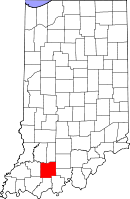 |
| Dubois County - Credit Wikipedia |
#10,895
While poultry farmers and the USDA have been waiting anxiously to see if Highly Pathogenic Avian Influenza would return this winter, the subtypes we've been expecting were HPAI H5's - specifically H5N2 and H5N8.
Today, in a surprise statement, APHIS has announced the detection of a completely different HPAI strain - H7N8.
There aren't a lot of citations for H7N8 beyond a handful of low path findings in healthy wild birds. Korea reported an outbreak of LPAI (low path) H7N8 in 2007.
 |
| Credit Influenza Research Database |
There is obviously a lot we are going to need to learn about this newest virus; how this HP strain evolved, how easily it transmits, and how it got past the farm's biosecurity measures.
For now, it is too soon to know how much of an impact this strain is going to have. But this latest finding does prove that influenza never ceases to surprise us.
USDA Confirms Highly Pathogenic H7N8 Avian Influenza in a Commercial Turkey Flock in Dubois County, Indiana
Contacts:
Andrea McNally (202)799-7033 andrea.c.mcnally@aphis.usda.gov
Lyndsay Cole (970)494-7410 lyndsay.m.cole@aphis.usda.govWASHINGTON, January 15, 2016 -- The United States Department of Agriculture’s (USDA) Animal and Plant Health Inspection Service (APHIS) has confirmed the presence of highly pathogenic H7N8 avian influenza (HPAI) in a commercial turkey flock in Dubois County, Indiana. This is a different strain of HPAI than the strains that caused the 2015 outbreak. There are no known cases of H7N8 infections in humans. As a reminder, the proper handling and cooking of poultry and eggs to an internal temperature of 165 ˚F kills bacteria and viruses, including HPAI.
Samples from the turkey flock, which experienced increased mortality, were tested at the Indiana Animal Disease Diagnostic Laboratory at Purdue University, which is a part of USDA’s National Animal Health Laboratory Network, and confirmed by USDA this morning. APHIS is working closely with the Indiana State Board of Animal Health on a joint incident response. State officials quarantined the affected premises and depopulation of birds on the premises has already begun. Depopulation prevents the spread of the disease. Birds from the flock will not enter the food system.
As part of existing avian influenza response plans, Federal and State partners are working jointly on additional surveillance and testing in the nearby area. The rapid testing and response in this incident is the result of months of planning with local, state, federal and industry partners to ensure the most efficient and effective coordination. Since the previous HPAI detections in 2015, APHIS and its state and industry partners have learned valuable lessons to help implement stronger preparedness and response capabilities. In September, APHIS published a HPAI Fall Preparedness and Response Plan that captures the results of this planning effort, organizing information on preparatory activities, policy decisions and updated strategy documents.
The United States has the strongest AI surveillance program in the world, and USDA is working with its partners to actively look for the disease in commercial poultry operations, live bird markets and in migratory wild bird populations.
Anyone involved with poultry production, from the small backyard to the large commercial producer, should review their biosecurity activities to assure the health of their birds. To facilitate such a review, a biosecurity self-assessment and educational materials can be found at http://www.uspoultry.org/animal_husbandry/intro.cfm
In addition to practicing good biosecurity, all bird owners should prevent contact between their birds and wild birds and report sick birds or unusual bird deaths to State/Federal officials, either through their state veterinarian or through USDA’s toll-free number at 1-866-536-7593. Additional information on biosecurity for backyard flocks can be found at http://healthybirds.aphis.usda.gov.
Additional background
Avian influenza (AI) is caused by an influenza type A virus which can infect poultry (such as chickens, turkeys, pheasants, quail, domestic ducks, geese and guinea fowl) and is carried by free flying waterfowl such as ducks, geese and shorebirds. AI viruses are classified by a combination of two groups of proteins: hemagglutinin or “H” proteins, of which there are 16 (H1–H16), and neuraminidase or “N” proteins, of which there are 9 (N1–N9). Many different combinations of “H” and “N” proteins are possible. Each combination is considered a different subtype, and can be further broken down into different strains. AI viruses are further classified by their pathogenicity (low or high)— the ability of a particular virus strain to produce disease in domestic chickens.